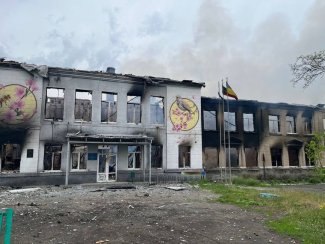Russia’s attack on Ukraine: day 90

Russian forces are continuing their efforts to cut off and eliminate the enemy grouping in the Sievierodonetsk area and to drive defenders from the border of the Kharkiv and Donetsk oblasts. There are ongoing clashes over Sievierodonetsk and surrounding towns in the Luhansk Oblast under Ukrainian control, as well as Lyman, the last major town northeast of Sloviansk. The invaders are also attempting to cut the Lysychansk-Bakhmut highway (by storming Yakovlivka and Bilohorivka in the Donetsk Oblast) and to capture the Horlivka-Popasna route (battles are being fought over the Troits’ke and Luhanske regions on the border, with 10 km of road between them remaining in Ukrainian hands). On the other directions the Russians continued to shell and bombard enemy positions and their hinterland, and occasionally took offensive actions. The targets of rocket attacks were Kryvyi Rih and Zaporizhzhia.
A spokesman for the Ministry of Defence of Ukraine presented summary data on the efforts of the aggressor army since the beginning of the invasion. He said that the enemy is preparing for a long-term military operation, while at the current stage of the conflict it is seeking to take control of the administrative borders of the Donetsk, Luhansk and Kherson oblasts to ensure a stable land corridor from Crimea. The Russians have so far committed nearly 170,000 troops, with over 90 battalion tactical groups (BTGs) used in combat operations. Up to and including May, the defenders were to destroy 17 enemy BTGs. Within one and a half to two months, the invaders may bring nearly 30 more BTGs into the fight.
Vladimir Rogov, the head of the Zaporizhzhia Oblast’s collaborationist administration, stated that once the region is ‘liberated’ from ‘Ukrainian nationalists’ it will become a full-fledged entity of the Russian Federation. He was critical of the need to establish the Zaporizhzhia People’s Republic and recalled that historically the lands of the region belonged to the Russian Empire. Rogov was one of the organisers of the ‘anti-Maidan’ in Zaporizhzhia in 2014. In September 2014, he was sent in a prisoner exchange to Russia, where he regularly appeared in the media as head of the Committee for the Construction of the State of Novorossiya and leader of the Slavonic Guard movement. In March 2022, with Russian support, he declared himself a member of the ‘military-civilian administration of the Zaporizhzhia Oblast’. Rogov’s declaration two weeks earlier had been preceded by a similar declaration by the collaborationist authorities in Kherson. They had announced that, having captured the entire Oblast, they would appeal to Vladimir Putin to incorporate it into Russia.
The Ministry of Defence of the Russian Federation has announced that the demining of the port of Mariupol has been completed and a ‘humanitarian’ corridor has been established for foreign ships staying there. The designated corridor, 115 miles long and 2 miles wide, is intended to allow five foreign-flagged vessels to enter the Black Sea. The rapid demining of the port indicates that the Russians intend to transport looted goods, including confiscated grain stocks and 200,000 tonnes of metallurgical products worth $170 million seized in Mariupol, by sea.
On 24 May, the EU Council approved the temporary liberalisation of foreign trade with Ukraine. In order to support the economy of the invaded country, import duties will be abolished, including on industrial and agri-food production, as well as suspended customs quotas and anti-dumping duties. The new rules are to be in force for one year. In addition, the Council approved the release of the fourth tranche of aid to Ukraine amounting to EUR 500 million from the European Peace Facility. The funds will be used for armaments for the army.
The Czech rail operator has announced the delivery to the German port of Brake of the first batch of 1,800 tonnes of corn from Ukraine to be exported to Egypt. The Croatian MFA announced its readiness to make available ports on the Adriatic Sea as part of an alternative export route for Ukrainian grain. In turn, the PRC Foreign Minister called for the creation of green corridors for grain exports from Ukraine and Russia.
Commentary
- Russian units and their constituent so-called Donetsk and Luhansk people’s militias have cut off defender forces in the area of Sievierodonetsk, the last part of the Luhansk Oblast under Ukrainian control. Fighting on the Lysychansk-Bakhmut road is preventing the delivery of support and supplies (including humanitarian aid) and evacuation, which had already been significantly limited in previous weeks due to artillery shelling by the aggressor. The alternative connection between the Ukrainian forces in the Sievierodonetsk area and the rest of the troops, i.e. the Zolotarivka-Siversk route, is a narrow local road with insufficient capacity as a supply line for a grouping estimated at several thousand soldiers and at least tens of thousands of civilians. It is also within range of enemy artillery from both sides. The defenders’ regaining control of the Lysychansk-Bakhmut road with their current forces should be considered unlikely (they do not have enough heavy weaponry to launch effective counterattacks), but this does not yet mean surrounding and surrendering the grouping. Depending on the command’s decision, it may attempt a breakthrough to the west or, as in the last weeks of the Mariupol defence, tie up the enemy troops for as long as possible.
- The development of the situation in the occupied territories indicates that, according to the most likely scenario, Russia will seek to annex the Kherson Oblast and part of Zaporizhzhia. It is also possible that in the event of the implementation of such a scenario, the question of the status of the so-called Donetsk and Luhansk People’s Republics will be on the agenda. Maintaining their façade independence will be pointless in the situation of implementing Russia’s enlargement plan. This means that they may also be incorporated into that country, which would allow the Kremlin to maintain the propaganda myth of the effective merging of ‘Russian lands’.
- The transport of the first batch of Ukrainian grain via the Czech Republic to Brake in the Weser delta once again confirms the effectiveness of the search for alternatives to the Black Sea and Sea of Azov ports, which remain under occupation or have been blocked by the Russian fleet. Earlier, grain deliveries to Constanta in Romania and Klaipeda in Lithuania were reported, and talks are also underway to use Polish ports on the Baltic. At the same time, it should be stressed that alternative routes are still far from sufficient – the 1.8 thousand tonnes of grain that reached Brake equals only about 1% of the daily exports from Ukrainian ports before the war.




